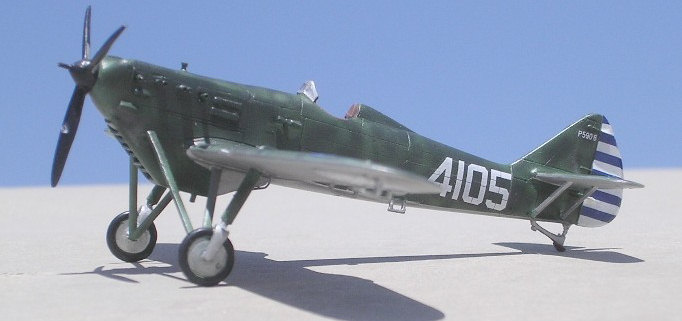
| KIT #: | 72065 |
| PRICE: | £15.50 |
| DECALS: | four options |
| REVIEWER: | Carmel J. Attard |
| NOTES: | short run kit with resin parts and vac windscreen |

| HISTORY |
After the French Air Force received its first production order for the D500 fighter, Dewoitine was instructed to complete two of the aircraft (the second and the tenth of the production run) to the revised D510standard that differed from that of the D500 and D501 mainly its up-rated power plant of one 775hp HS 12 Ycrs Vee engine, although other modifications increased the fuel capacity and altered the main landing gear units. The new engine larger and heavier than the Hispano Suiza 12 Xcrs unit it replaced, demanding the lengthening of the fuselage but had the same provision of a 20mm cannon between its cylinder banks to fire through the hollow propeller shaft.
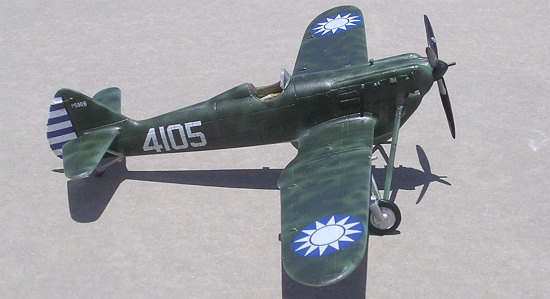 The D.510 revealed better performance than the D500 and D501
without any appreciable degradation of agility and was introduced into
production by contract of October 1936 which called for am initial order
delivery of 35 ( later turned to 25). Delivery of the D.510C1 started in
October 1936. Another order for 7 that were diverted to Lithuania from French
order. Later contracts called for 80 more aircraft including 24 D.510C and 36
D.510J fighters for the Air Force of Chinese Central Government and Turkey.
Those of the latter were not delivered. Other orders were placed by Japan, UK,
and USSR for one, two and one aircraft respectively for evaluation that led to
no production order. The D.510C1 was obsolete but still equipped three first
line Groupes de Chasse (fighter wings) which received more modern
equipment in the first months of the war. Some of the aircraft were allocated to
a pair of Escadrilles Regionales de Chasse in North Africa and others to
a pair of Aeronautique Navale Squadrons created in December 1939 and May
1940.
The D.510 revealed better performance than the D500 and D501
without any appreciable degradation of agility and was introduced into
production by contract of October 1936 which called for am initial order
delivery of 35 ( later turned to 25). Delivery of the D.510C1 started in
October 1936. Another order for 7 that were diverted to Lithuania from French
order. Later contracts called for 80 more aircraft including 24 D.510C and 36
D.510J fighters for the Air Force of Chinese Central Government and Turkey.
Those of the latter were not delivered. Other orders were placed by Japan, UK,
and USSR for one, two and one aircraft respectively for evaluation that led to
no production order. The D.510C1 was obsolete but still equipped three first
line Groupes de Chasse (fighter wings) which received more modern
equipment in the first months of the war. Some of the aircraft were allocated to
a pair of Escadrilles Regionales de Chasse in North Africa and others to
a pair of Aeronautique Navale Squadrons created in December 1939 and May
1940.
The Dewoitine D.510 was involved in other activities in Morocco and later also in Dakar until being replaced by more advanced aircraft as the Curtiss H-75 at the end of 1941. The D.510C also took part in the Spanish Civil War circa mid 1936 and in same year 24 were sold to China where they served with the Chinese Central Government and saw action against the Japanese including the defence of Changdu and the then capital Chongqing. The D.510 had a length of 26, a span of 39 8 and a height of 711. It attained a maximum speed of 250mph at 16,405 altitude and had a range of 435 miles.
| THE KIT |
The recent addition to Pavla 1/72 scale series represents
another French Air Force aircraft that evolved in the mid 30s by the Dewoitine
factory as the first low wing monoplane fighter . As a design it was a somewhat
simple aircraft and this is reflected in the kit which is less complex than
their other releases to assemble. The kit comes in the usual Pavla style of
coloured box displaying four colour side views that represent each and every
colour finish offering in the kit box. It has a 12 page clear A5 size
instruction booklet which is easy to follow.
. As a design it was a somewhat
simple aircraft and this is reflected in the kit which is less complex than
their other releases to assemble. The kit comes in the usual Pavla style of
coloured box displaying four colour side views that represent each and every
colour finish offering in the kit box. It has a 12 page clear A5 size
instruction booklet which is easy to follow.
The kit consists of one grey sprue with 41 injected plastic pieces with engraved detail, several resin sprues, cream coloured containing 41 detail parts, and a pair of vac form windscreens which includes a spare one. The colour options consist of three French Air Force aircraft and another aircraft in china Air Force markings. Two of the French Air Force are silver overall with beautiful selection of decals, another is in 4 tone French camouflage which also carries a fancy squadron insignia while the last machine is a Chinese Air Force with an interesting camouflage of light green and darker green mottle, and silver underside.
| CONSTRUCTION |
Construction inevitably starts with the cockpit, much of
which is in resin detail parts that includes side consoles, instrument panels in
three separate pieces, crew seat with embossed detail seat belt, a control
column and rudder pedals. These were all pre-painted and assembled into one
unit. The cockpit assembly being green with silver painted oxygen bottles and
instruments mainly in black and silver etc is then fixed to one side of the
fuselage halves. In order to fit inside the lower corner of the side
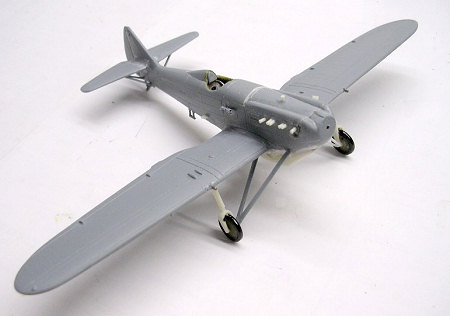 consoles
needed to be sanded at the back. The fuselage was then closed and allowed to
set. There is a sizeable lower radiator. This has a front aperture which can be
assembled in closed format but I elected to build this in the open format. There
are 7 separate rectangular louvers which are cut to the size 6x2mm as per
instructions given. This gives more detail to the forward area which proved very
effective in the end. One should point out that the louvers closer to the prop
gradually widen from a length of 6mm to 7mm. The radiator also has a central
rectangular piece which is built from scratch as per instructions and is fitted
at the interior. This will stop the see-through effect. Interior is painted in
dark shade of green.
consoles
needed to be sanded at the back. The fuselage was then closed and allowed to
set. There is a sizeable lower radiator. This has a front aperture which can be
assembled in closed format but I elected to build this in the open format. There
are 7 separate rectangular louvers which are cut to the size 6x2mm as per
instructions given. This gives more detail to the forward area which proved very
effective in the end. One should point out that the louvers closer to the prop
gradually widen from a length of 6mm to 7mm. The radiator also has a central
rectangular piece which is built from scratch as per instructions and is fitted
at the interior. This will stop the see-through effect. Interior is painted in
dark shade of green.
There are two sets of exhaust stabs, each consisting of 6 on each side. Each of these resin pieces need to be reduced in length by 30% and these will add detail to the kit nose area when in place. One should note that the exhaust area has an opening which is well reproduced and therefore one should make note of the end part and to cut length from the other end. A venturi fitting is also fitted to the port side close to the cockpit. Using a pin drill I drilled an opening to both the forward and the rear ends of the instrument. There is a one piece three bladed propeller which contained a bit of flash which is gently removed. Each prop blade could also be slightly improved if the trailing edge is scraped down to a thinner taper in section.
The long wing comes in four parts. These needed to be cleaned
towards the ends by removing the flash. There are embossed ejector pin marks on
the inside of the wing halves that require to be sanded down prior to assembly
of the wing parts to make the t wo complete side wings. There is a choice of gun
positions so these are either fitted to under-wing pods or in case of the
Chinese version I followed the instructions and drilled a 1mm diameter hole at
places indicated, one on each wing and the guns supplied were fixed in place.
One should be careful not to be misled by the colour side view given which shows
the guns mounted in pods under the wings on the Chinese version as well. Since I
choose to builds the Chinese machine I used a set of resin main gear legs which
comes without the wheel spats. Control links fitted to upper fin and rudder are
made from thin 3mm long stretch sprue. Their presence shows clearly on each of
the colour side views. Another control link slightly longer than the previous
one is added to connect the rudder trim tab and rudder.
wo complete side wings. There is a choice of gun
positions so these are either fitted to under-wing pods or in case of the
Chinese version I followed the instructions and drilled a 1mm diameter hole at
places indicated, one on each wing and the guns supplied were fixed in place.
One should be careful not to be misled by the colour side view given which shows
the guns mounted in pods under the wings on the Chinese version as well. Since I
choose to builds the Chinese machine I used a set of resin main gear legs which
comes without the wheel spats. Control links fitted to upper fin and rudder are
made from thin 3mm long stretch sprue. Their presence shows clearly on each of
the colour side views. Another control link slightly longer than the previous
one is added to connect the rudder trim tab and rudder.
The rest of kit assembly went straight forward, with the main and aft wings butt jointed and fixed straight when viewed from front. Perhaps one may suggest here that a front view line drawing will be helpful to ensure that the wings are of a straight fix configuration and have no anhedral to any degree. When fixing the tail planes one should ensure to fix the wings with the elevators of both tail planes forming a straight line. This is achieved by sanding the rear root of the tail plane wings prior to fitting in place. I also added two connecting pipes that join the fuel tank aft of the radiator to two connections under the wings as displayed on my model and also indicated in side views.
| COLORS & MARKINGS |
Instruction gives clear indication of colour to detail parts with colour reference to follow as indicated in the comprehensive preview of this kit by Scott. There is a minor observation to add in that whereas there is a colour reference quoted to letters BCEFGHIK, that for A and D on Page 9 is not indicated and considering the items that these refer to I discerned that these are cockpit green and zinc chromate as appropriate to the area where D should be a tyre pigment such as matt black.
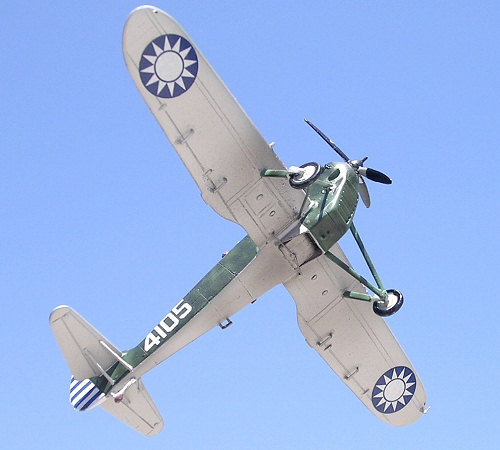 The Chinese version that I made my kit to represent was
painted in mottle shades of green upper surfaces and silver undersides. The
cockpit and wind screen area were first blanked with tissue paper and Maskol.
For the upper surfaces I started by painting the surface camouflage in a paler
shade of medium green. This was achieved by adding few drops of white and lesser
drops of yellow to Compucolor CA3 medium green ANA612. These were mixed in the
airbrush cup and 30% thinner added. After allowed to dry for a couple of hours
spots of mottle were applied at will use olive drab mixed with a few drops of
black and with thinner. This was appreciably applied until a contrast between
the two paint shades is retained. After allowed to dry the upper surfaces were
masked and a mix of silver and varnish was applied to the lower surfaces.
Following this a mix of varnish and engine grey was applied to the radiator
exhaust area and also to wing guns in way of slip stream.
The Chinese version that I made my kit to represent was
painted in mottle shades of green upper surfaces and silver undersides. The
cockpit and wind screen area were first blanked with tissue paper and Maskol.
For the upper surfaces I started by painting the surface camouflage in a paler
shade of medium green. This was achieved by adding few drops of white and lesser
drops of yellow to Compucolor CA3 medium green ANA612. These were mixed in the
airbrush cup and 30% thinner added. After allowed to dry for a couple of hours
spots of mottle were applied at will use olive drab mixed with a few drops of
black and with thinner. This was appreciably applied until a contrast between
the two paint shades is retained. After allowed to dry the upper surfaces were
masked and a mix of silver and varnish was applied to the lower surfaces.
Following this a mix of varnish and engine grey was applied to the radiator
exhaust area and also to wing guns in way of slip stream.
The decals are of excellent quality, the usual Pavla product, with opaque colours, thin, strong and adhere very well. In making the Chinese version I noticed that roundels are given to go to both the upper and lower wing surfaces. While the instructions did not show the ones to go over the wing, I did some research and discovered that these were in fact present although other aircraft types in service with the Chinese AF did not necessarily carry these. My kit represented a Dewoitine D.510C of 41st Chungtui of the Chinese Central Government. It was flown by William Labussiere, a French volunteer pilot who fought against the Japanese from Kunming airfield.
| CONCLUSIONS |
All in all this is an accurate and well detailed model. First impression is that this is a clean design. But with all the additional detail parts given that goes on external surfaces this will turn the kit into a pleasing gem and a nice addition to any collection. I certainly have no hesitation in recommending it to anyone even to those who have never tried their hands on a short run kit before and certainly to anyone with a flavour of unusual subjects.
| REFERENCES |
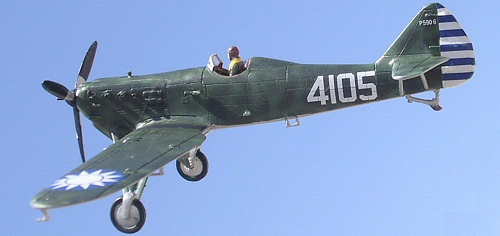 Kit
instructions
Kit
instructions
Pocket Encyclopaedia Fighters between wars 1919-39
MM kit preview
August 2007
Copyright ModelingMadness.com. All rights reserved.
If you would like your product reviewed fairly and fairly quickly, please contact the editor or see other details in the Note to Contributors.